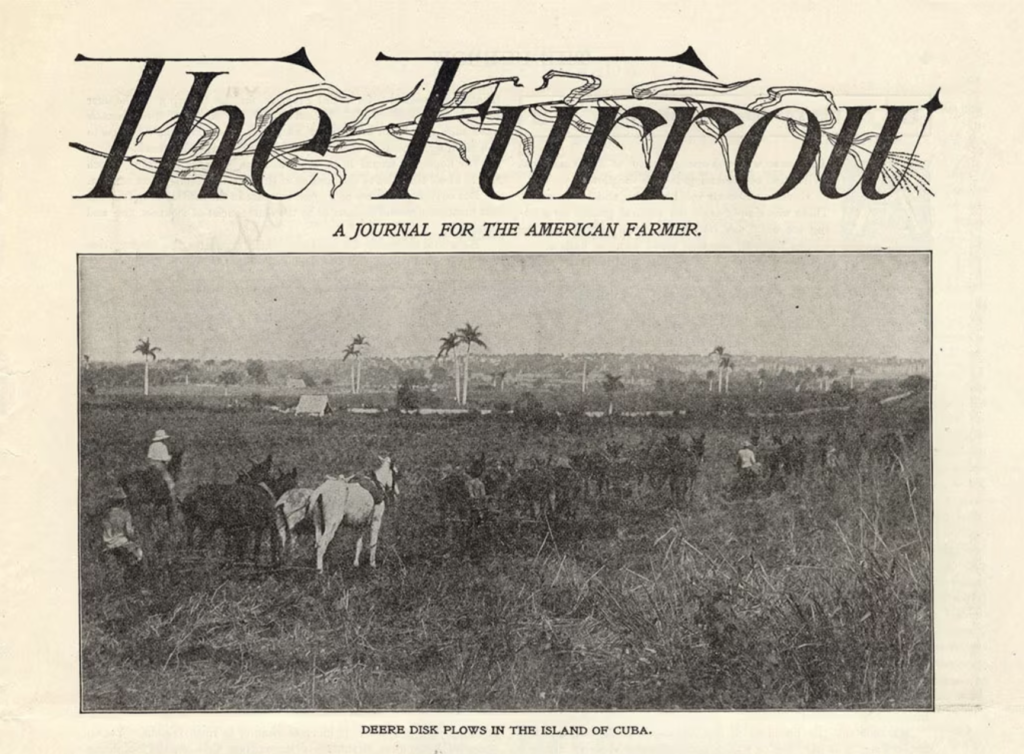Content marketing is often described as a new thing – a natural result of widespread digital brand transformation and our ever-increasing content consumption habits. But story-driven content marketing was just as effective at engaging audiences in the 19th and 20th centuries as it is in 2023.

In 1895, John Deere published the first edition of its agrarian magazine for farmers, The Furrow.
Sent out to John Deere’s farmer-customers, The Furrow contained advertisements for the company’s horse-drawn farming equipment, surrounded by editorial pages carrying information about the latest farming practices. Delivered by the brand-new (at the time) US Post Office’s ‘Rural Free Delivery’ service, the magazine quickly gained a strong readership – with a circulation of 1.4 million by 1912.
The Furrow didn’t hesitate to embrace new trends and adapt to new norms. Not only did it embrace the advent of the US postal service in then 1890s, but it’s still going strong today with an additional digital presence to its print magazine.
But what does a 128-year-old magazine have to do with today’s content marketing landscape? The well-established purpose, The Furrow’s Editorial Director Anne East affirms, is to tell stories that inform and entertain.
How content marketing works – the VW Lemon
Content marketing is the concept that all brands, in order to attract and retain customers, need to think and act like media companies – transforming marketing departments into something more akin to a publishing house.
This is more than just advertising. Whether it’s a humble corporate blog or a sprawling production of podcasts, eBooks, magazines, video series or webinars – this is a brand itself creating content. Valuable, relevant, informational, entertaining, or otherwise serving a purpose adjacent to just selling.
If examined closely, the reasons for the sudden growth in content marketing over the last decade are clear; barriers to entry for entrepreneurial SMEs have fallen, digital transformation has resulted in more content consumption than ever, meaning that the competition across almost all sectors has intensified. Professional and clear advertisements for products or services will no longer stand out, or even hold a place, among the crowd if they do not provide additional value to a customer.
In any competitive environment, success finds those willing to innovate and surpass their peers. As a result, the best examples of marketing have become significantly more complex – choosing to tell an emotional story rather than bombard consumers with prices and statistics.

Volkswagen’s 1960 ‘Lemon’ advert is synonymous with the beginning of modern marketing. Multiple storytelling devices, like those you might find in a literary novel or a blockbuster movie, are used in this short and simple advert.
We can start with the obvious – by providing this image of a (very monochrome) Volkswagen Beetle alongside the tagline of ‘Lemon’, the advert creates a ‘hook’ for any potential readers by keeping the link between this pairing of image and caption unexplained. In fact, the short text below the advert, which is more akin to flash fiction than traditional copywriting, doesn’t reveal the reason for the ‘Lemon’ tagline until the very end of the text – pulling the reader through the entire story.
Sharing similarities to traditional journalism, we have our first step for successful content marketing: create an interesting ‘hook’ for the reader.
Can you spot anything missing? Additional features? Top speed? Construction materials?
The advert wastes no time focusing on emotionless numbers or facts. Instead, it humanises Volkswagen by introducing a character, in the form of a dedicated employee whose only goal is to ensure only flawless cars are produced. Instead of learning the expected miles-per-gallon, the reader is given a mental image of a pristine, futuristic VW factory building the perfect cars – a far more powerful and effective endorsement of the brand itself.
Well-written, interesting, and containing a flash of humour – the advert is a worthy piece of short writing itself, where the process of ‘selling’ takes a subtler background position. As consumers, we feel respect for ‘Inspector Kurt’ and awe for the entire VW manufacturing process. Rather than facts or figures, the advert drives an emotional response and is therefore far more effective.
If this is all sounding a bit familiar, it should: emotional storytelling centred on relatable characters remains a central tenet of marketing today.
Adding emotion to your content marketing
A lot has changed since The Furrow’s first edition and VW’s Lemon, but the human condition remains the same. The same types of heroic or tragic stories drive an emotional response in us when we read or watch them, and there is a lot to learn from historically successful advertising. As a starting point, stay focused on the critical elements of effective content:
- Keep it human
A story should be about people, not products. The best content marketing will include characters (real or imagined), personal experience, conflict and authenticity. 95% of consumers are more loyal to brands that are genuine and transparent.
- Trust your audience
People are smart, and they want to be trusted. Allow them space to put the story together themselves – often the less detail there is, the more effective the story. This Lego campaign is an excellent example of trusting an audience to understand the message and meaning behind the ad. Show, don’t tell.
- Stay relevant
A gifted storyteller can find a story anywhere. For a good story to become effective content marketing, it needs to be effectively tied in with the brand it promotes. There’s no universal secret to achieving this as every brand is different but – understanding your target audience’s everyday desires and difficulties is a good starting point.
- Add value
Adverts and marketing are everywhere and very easily become annoying. It’s not enough to push products or services in front of consumers – they need to be offered something in return for their time. Whether it’s a satisfying story, a quick joke, or even just a new idea or concept, your content needs to have a reason to exist beyond product promotion.
- Find originality
There’s nothing new under the sun. With the enormous amount of promotional content produced across digital and print channels, finding an original idea might feel like an impossible ask. Concentrate on what your brand does that others cannot, whether it’s exclusive USPs or a unique type of consumer audience. Good artists copy, great artists steal.

Content Marketing: 128 years of success and counting
The ongoing success of both John Deere and The Furrow since the first 1895 edition is an important lesson in creating effective and memorable content marketing. Genuine, empathetic stories about people remain one of the most powerful methods of brand promotion, entertaining consumers and adding real value to branded content and advertisements.
Tom Sizemore, Art Director and part of The Furrow for the past 37 years, credits the magazine’s success to keeping the focus on the farmers themselves, rather than John Deere’s equipment.
“Even the most technical subject has to have a human story behind it,” editor David Jones added. “We’ve always been able to convince the management that the content shouldn’t be about John Deere equipment. We’ve stuck to that the whole time.”
For more from Tom, read about the green SMEs driving positive change in across industries.

